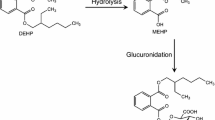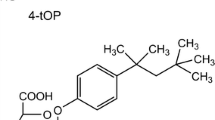Abstract
Pentachlorophenol has earlier been shown to be metabolized in mammals to tetrachloro-p-hydroquinone. The metabolite possesses pronounced inhibitory activity on bacterial β-glucuronidase but not on β-glucuronidase from liver. Indirect evidence for the occurrence of both pentachlorophenol and tetrachloro-p-hydroquinone as conjugates with glucuronic acid in the urine from pentachlorophenol-treated rats is now presented. Bovine liver β-glucuronidase has been utilized to split the conjugates present.
The in vivo metabolism of pentachlorophenol has also been studied in rats treated with phenobarbital and β-diethylaminoethyldiphenyl propylacetate (SKF 525-A). In vitro metabolism has been studied using liver microsomes from rats pretreated with phenobarbital. Quantitative analysis of the compounds occurring in extracts of urine or extracts from the microsomal incubates was performed by means of mass fragmentography. Pretreatment with phenobarbital increased the metabolism of pentachlorophenol to tetrachloro-p-hydroquinone both in vivo and in vitro. SKF 525-A, however, inhibited the metabolism in vitro but enhanced the metabolism in vivo when given less frequently than every 6th h. Dechlorination of pentachlorophenol is mediated by microsomal enzymes that can be induced by phenobarbital. SKF 525-A does not inhibit the dechlorination in vivo but does so in vitro.
Zusammenfassung
Wie in früheren Versuchen gezeigt worden ist, wird Pentachlorphenol bei Säugern zu Tetrachlor-p-Hydrochinon metabolisiert. Dieser Metabolit wirkt ausgeprägt hemmend auf Bakterien-β-Glucuronidase, aber nicht auf Leber-β-Glucuronidase. Ein indirekter Beweis für das Vorkommen von sowohl Pentachlorphenol als auch Tetrachlor-p-Hydrochinon als Konjugate mit Glucuronsäure im Harn von pentachlorphenolbehandelten Ratten wird nun vorgelegt. Zur Spaltung der gegenwärtigen Konjugate wurde Rinderleber-β-Glucuronidase benutzt.
Der in vivo-Abbau von Pentachlorphenol wurde auch an mit phenobarbital und mit β-Diäthylaminoäthyl-Diphenyl-Propylacetat (SKF 525-A) behandelten Ratten untersucht.
Beim Studium des in vitro-Abbaus wurden Lebermikrosomen von mit Phenobarbital behandelten Ratten benutzt. Phenobarbital steigerte die Umwandlung in Tetrachlor-p-Hydrochinon sowohl in vivo als auch in vitro. SKF 525-A verzögerte indessen den in vitro-Umsatz, steigerte ihn jedoch in vivo, wenn weniger oft als alle 6 Std gegeben. Die Untersuchung zeigt also, daß die Entchlorung von Pentachlorphenol durch Mikrosomenenzyme vermittelt wird, die durch phenobarbital angeregt werden können. SKF 525-A hemmt die Entchlorung nicht in vivo, wohl aber in vitro.
Similar content being viewed by others
References
Ahlborg, U. G., Lindgren, J.-E., Mercier, M.: Metabolism of pentachlorophenol. Arch. Toxicol. 32, 271–281 (1974)
Ahlborg, U. G., Manzoor, E., Thunberg, T.: Inhibition of β-glucuronidase by chlorinated hydroquinones and benzoquinones. Arch. Toxicol. 37, 81–87 (1977)
Anders, M. W.: Enhancement and inhibition of drug metabolism. Ann. Rev. Pharmacol. 11, 37–56 (1971)
Anders, M. W., Mannering, G. J.: Inhibition of drug metabolism. I. Kinetics of the inhibition of the N-demethylation of ethylmorphine by 2-diethylaminoethyl 2,2-diphenylvalerate HCl (SKF 525-A) and related compounds. Molec. Pharmacol. 2, 319–327 (1966)
Anders, M. W., Alvares, A. P., Mannering, G. J.: Inhibition of drug metabolism. II. Metabolism of 2-diethylaminoethyl 2,2-diphenylvalerate HCl (SKF 525-A). Molec. Pharmacol. 2, 328–334 (1966)
Braun, W. H., Sauerhoff, M. W.: The pharmacokinetic profile of pentachlorophenol in monkeys. Toxicol. appl. Pharmacol. 38, 525–533 (1976)
Conney, A. H.: Pharmacological implications of microsomal enzyme induction. Pharmacol. Rev. 19, 317–366 (1967)
Cranmer, M., Freal, J.: Gas chromatographic analysis of pentachlorophenol in human urine by formation of alkyl ethers. Life Sci. 9, 121–128 (1970)
Elkin, K., Pierrou, L., Ahlborg, U. G., Holmstedt, B., Lindgren, J.-E: Computer controlled mass fragmentography with digital signal processing. J. Chromatogr. 81, 47–55 (1973)
Ernster, L., Siekevitz, T., Palade, G. E.: Enzyme-structure relation ships in the endoplasmic reticulum of rat liver. J. cell. Biol. 15, 541–562 (1962)
Jacobson, I., Yllner, S.: Metabolism of 14C-pentachlorophenol in the mouse. Acta pharmacol. (Kbh.) 29, 513–524 (1971)
Kato, R., Chiesara, E., Vassanelli, P.: Further studies on the inhibition and stimulation of microsomal drug-metabolizing enzymes of rat liver by various compounds. Biochem. Pharmacol. 13, 69–83 (1964)
Lowry, O. H., Rosebrough, N. J., Farr, A. L., Randall, R. J.: Protein measurement with the folin phenol reagent. J. biol. Chem. 193, 265–275 (1951)
Miller, G. L.: Protein determination of large numbers of sample. Anal. Chem. 31, 964 (1959)
Serrone, D. M., Fujimoto, J. M.: The effect of certain inhibitors in producing shortening of hexobarbital action. Biochem. Pharmacol. 11, 609–615 (1962)
Sigma Chemical Co., St. Louis, Mo., USA. Data sheet bovine liver β-glucuronidase type B-1, 1973
Stitzel, R. E., Anders, M. W., Mannering, G. J.: Inhibition of drug metabolism. III. Inhibition of hexobarbital metabolism in the intact rat and in the isolated perfused liver by 2-diethylaminoethyl 2,2-diphenyl valerate HCl (SKF 525-A) and its N-deethylated derivatives. Molec. Pharmacol. 2, 335–340 (1966)
Author information
Authors and Affiliations
Rights and permissions
About this article
Cite this article
Ahlborg, U.G., Larsson, K. & Thunberg, T. Metabolism of pentachlorophenol in vivo and in vitro. Arch Toxicol 40, 45–53 (1978). https://doi.org/10.1007/BF00353278
Received:
Published:
Issue Date:
DOI: https://doi.org/10.1007/BF00353278




